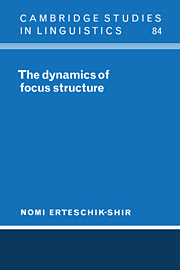Book contents
- Frontmatter
- Contents
- Acknowledgments
- Introduction
- 1 The interpretation of f-structure
- 2 Reference and coreference
- 3 Negation, questions, and contrast
- 4 The phonological interpretation of f-structure
- 5 Scope and R-dependencies
- 6 I-dependencies in focus structure
- Conclusion
- Notes
- References
- Index of names
- Index of subjects
Conclusion
Published online by Cambridge University Press: 02 September 2009
- Frontmatter
- Contents
- Acknowledgments
- Introduction
- 1 The interpretation of f-structure
- 2 Reference and coreference
- 3 Negation, questions, and contrast
- 4 The phonological interpretation of f-structure
- 5 Scope and R-dependencies
- 6 I-dependencies in focus structure
- Conclusion
- Notes
- References
- Index of names
- Index of subjects
Summary
The purpose of this book was to show that f-structure is a basic component of the language faculty which interacts essentially with phonology, syntax and semantics as well as pragmatics. F-structure marks the organization of sentences into focus and topic constituents. In Erteschik-Shir and Lappin (1987) we argue that all modes of perception are organized into foreground and background constituents. Focusing is viewed as a single task-specific mechanism which identifies the foregrounded constituent in representations of all modular systems. Focusing is therefore a nonmodular process which provides the interface between the modular system and the central cognitive mechanisms. It follows that although focusing plays a central role in grammar, it is not unique to the language faculty. The identification of a topic is, however, characteristic of linguistic structure. In vision, for example, foregrounding is necessary for the formation of a visual report, but this report is not “about” anything, i.e., it does not have a topic. Whereas the capacity to identify a topic is a distinctive property of the human brain and of the language faculty in particular, focusing is a basic property of all cognitive systems.
The linguistic level of f-structure in which both topic and focus are identified is therefore a fundamental part of Universal Grammar (UG) which determines the class of possible languages. I have argued in this book that the rule of predication takes f-structures as its input producing a well-formed discourse representation. F-structure can therefore be viewed as an interface level between the grammar and the conceptual–intentional system replacing LF. F-structure also mediates grammar and PF (Phonetic Form), itself an interface level with the articulatory–perceptual system.
- Type
- Chapter
- Information
- The Dynamics of Focus Structure , pp. 236 - 238Publisher: Cambridge University PressPrint publication year: 1998



